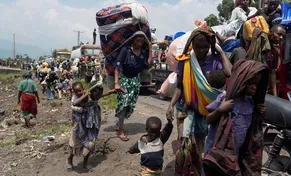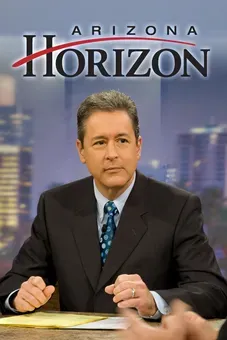
The hazards of wildfire smoke, even hundreds of miles away
Clip: 6/8/2024 | 5m 22sVideo has Closed Captions
Wildfire smoke is hazardous even hundreds of miles away. Here’s how to protect your health
Smoke from wildfires hundreds of miles away is still a health threat, contributing to nearly 16,000 deaths a year, according to a recent National Bureau of Economic Research analysis. Laura Kate Bender, who leads the Healthy Air campaign for the American Lung Association, joins John Yang to discuss what makes wildfire smoke so hazardous and how people can protect themselves.
Problems with Closed Captions? Closed Captioning Feedback
Problems with Closed Captions? Closed Captioning Feedback
Major corporate funding for the PBS News Hour is provided by BDO, BNSF, Consumer Cellular, American Cruise Lines, and Raymond James. Funding for the PBS NewsHour Weekend is provided by...

The hazards of wildfire smoke, even hundreds of miles away
Clip: 6/8/2024 | 5m 22sVideo has Closed Captions
Smoke from wildfires hundreds of miles away is still a health threat, contributing to nearly 16,000 deaths a year, according to a recent National Bureau of Economic Research analysis. Laura Kate Bender, who leads the Healthy Air campaign for the American Lung Association, joins John Yang to discuss what makes wildfire smoke so hazardous and how people can protect themselves.
Problems with Closed Captions? Closed Captioning Feedback
How to Watch PBS News Hour
PBS News Hour is available to stream on pbs.org and the free PBS App, available on iPhone, Apple TV, Android TV, Android smartphones, Amazon Fire TV, Amazon Fire Tablet, Roku, Samsung Smart TV, and Vizio.
Providing Support for PBS.org
Learn Moreabout PBS online sponsorshipJOHN YANG: Last month, even before summer began, smoke from Canadian wildfires triggered air quality alerts in the upper Midwest and Great Plains and at the same time, fires in Mexico affected air quality along the Gulf Coast from Texas to Florida.
It all brought back memories of last year's record setting fires in Canada that set a haze of smoke drifting over the Midwest and east coast.
Smoke from wildfires hundreds of miles away is still ahead threat.
A recent National Bureau of Economic Research analysis says it contributes to nearly 16,000 deaths a year.
Laura Kate Bender leads the Healthy Air Campaign for the American Lung Association.
Laura Kate what is in wildfire smoke that makes it so hazardous?
LAURA KATE BENDER, American Lung Association: One of the main components of wildfire smoke that's so dangerous is fine particle pollution.
These tiny bits of stuff can get deep into your lungs, and if they're small enough, they can even get into your bloodstream when they cause a host of health harms.
There's a bunch of other harmful chemicals and wildfire smoke too, particularly if it's burning houses, cars and other things from built structures.
JOHN YANG: Is it just as dangerous if the fire is hundreds of miles away, or if the fire is down the street?
LAURA KATE BENDER: Neither is safe.
It can change the composition.
It can change the mix.
But the fact remains that people, whether close to the fire or far away, should both take precautions.
JOHN YANG: What are the health threats?
What can wildfire, inhaling wildfire smoke bring on?
LAURA KATE BENDER: What people might experience during the smoke event is they might have burning eyes, a burning throat, coughing or wheezing.
If you have asthma, COPD or another lung disease, you could actually have an exacerbation.
People can have heart attacks and strokes, and it goes all the way up to premature death.
So there can be some really serious health consequences.
JOHN YANG: Premature death from illness brought on by the smoker from the trauma breathing in the smoke at the moment?
LAURA KATE BENDER: We know that particle pollution itself can cause premature death from both short term and long term exposures, and we know that wildfire smoke can exacerbate existing lung and heart disease and cause some of those health impacts that can send you to the hospital or even cause premature death.
JOHN YANG: What should people do to protect themselves?
LAURA KATE BENDER: People can take steps before, during and after a wildfire.
Before, you should get in the habit of checking your air quality.
Airnow.gov is a great place to do it.
It's also on weather reports.
People can also prepare now, for example, if they think they're going to get smoke this summer again, they might want to buy an air cleaner, a device that they can use that doesn't add pollution to the air, that just filters it.
And then, in the event of a fire, people should stay out of the smoke.
If you're in your home, you can run that air cleaner in a closed off room to create as much of a clean space as possible.
You can make sure your air conditioner, if you have central AC, is recirculating, not pulling air in from the outside.
You can readjust your plans.
If you have exercise outdoors plans that day, for example, that would be a good day to move that indoors.
JOHN YANG: Even if you live hundreds of miles away from where wildfires are likely to take place.
These are precautions you should be taking?
LAURA KATE BENDER: Absolutely if smoke is in the forecast.
You know, I think myself and many others experienced after thinking of wildfires as more of a West Coast problem.
Here in the DC area, we had days with hazardous levels of air pollution, and I, as someone with asthma, absolutely changed my routine to make sure that I wasn't exercising outdoors on those days.
JOHN YANG: Mentioned people with asthma.
Are there other any other populations who need to be particularly careful?
LAURA KATE BENDER: Wildfire smoke can impact health for anyone.
But if you are an older adult, if you are a child, if you're pregnant, if you spend a lot of time outdoors, either working or exercising, or if you have an underlying condition like a lung or a heart disease, those are some of the things that can put you at greater risk of health harm.
JOHN YANG: It can affect anybody.
But is there evidence that any groups are disproportionately affected?
LAURA KATE BENDER: Unfortunately, we know, as with so many air pollution issues, that communities of color and low income communities tend to be at greater risk.
JOHN YANG: Why is that?
LAURA KATE BENDER: Unfortunately, histories of redlining, other practices that have left people with polluting sources close to their neighborhoods that creates a lot of overlapping risk factors.
We also know that people might be more likely to work outdoors, be less likely to have central air conditioning or a car that they can keep the windows closed and the AC on.
And so there's a lot of factors that could put people at greater risk of not just exposure, but also health harms from those exposures.
JOHN YANG: And I know the American Lung Association has ideas or suggestions about what can be done to mitigate these dangers and the fires themselves.
What would the Lung Association like to see done?
LAURA KATE BENDER: For individuals, everybody can and should take steps to protect themselves.
We have resources at lung.org/wildfire.
Folks can also use the website I mentioned earlier, airnow.gov to look up their air quality.
Policy makers at every level also have a role to play.
Number one, we know that climate change is making wildfire risk worse, so continued action on climate change, implementing the policies we have to clean up our cars and our power plants and doing more will help make this problem less likely to get worse in the future.
One more policy recommendation is the use of prescribed fire.
It's a tough trade off, but we know that prescribed fire under the right circumstances, can help make catastrophic wildfires less likely.
JOHN YANG: Controlled fires sort of burning away the underbrush.
LAURA KATE BENDER: Yes, and there's steps that we can take to make that less risky for lung health.
It's an unfortunate trade off, but it can help make lung health better over the long term under the right circumstances.
JOHN YANG: Laura Kate Bender of the American Lung Association, thank you very much.
LAURA KATE BENDER: Thanks for having me.
As temperatures rise, more schools struggle to beat the heat
Video has Closed Captions
As temperatures rise, schools without AC struggle to keep students healthy and learning (5m 26s)
Escalating conflict in Congo fuels humanitarian crisis
Video has Closed Captions
Escalating conflict in Democratic Republic of Congo fuels growing humanitarian crisis (7m 44s)
Providing Support for PBS.org
Learn Moreabout PBS online sponsorshipSupport for PBS provided by:
Major corporate funding for the PBS News Hour is provided by BDO, BNSF, Consumer Cellular, American Cruise Lines, and Raymond James. Funding for the PBS NewsHour Weekend is provided by...













